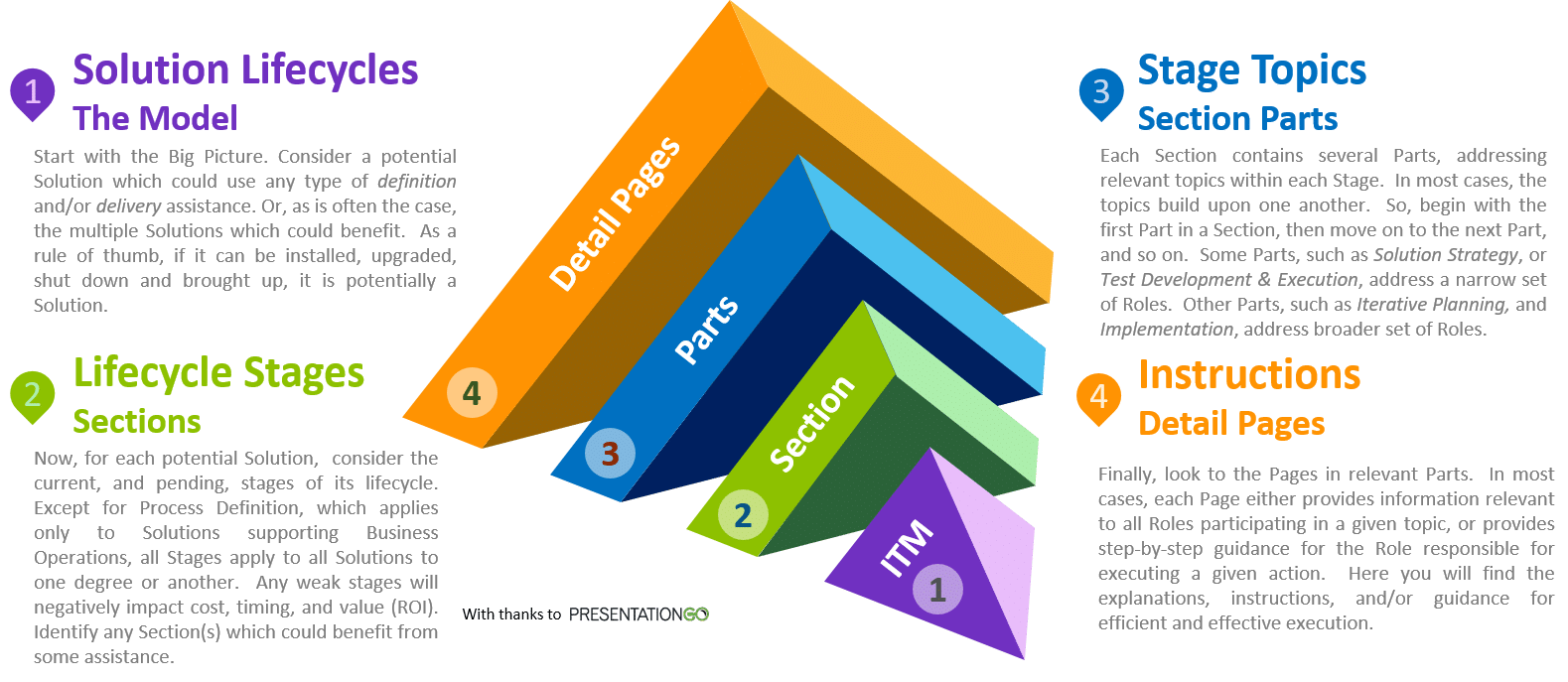The second part of the Model Orientation describes the Model's Content. After viewing how the Model's Structure, this is a first look at the Model's Content. The ITM incorporates knowledge, experience, tools, and artifcats, derived over decades of ERP Consulting. Accordingly, it embodies many best practices and lessons learned, sparing consumers the time it takes to learn such improvements on their own.
First, let's describe how the Model is broken down into multiple Sections, and the purpose of each. Sections address a Stage within a Solution's lifecycle. However, because the Model is iterative, each Stage may be revisited many times over a Solution's lifecycle.
Then we'll look at how to select the Section(s) that can provide the guidance and assistance sought by consumers. Recall, the Model's design provides support where and when needed. Some consumers may find a single Section provides the help desired. Others may opt for several Sections, or the Full Model for maximum benefit.
Sequence of Solution Lifecycle Events

Each ITM Section addresses one aspect of a Solution's lifecycle. The Model's design allows for use in multiple ways. First, for use on any individual subject. Second, for use on subject groups related to Solution Definition or Solution Delivery. Finally, it can offer an holistic approach, covering the full lifecycle of transformative, enterprise-level Solutions.
Any single Section will provide value on its own. However, applying more Sections related to one another provides even better results. This is due to the increased scope of alignment and consistency which the Model provides. The more participants row the same direction, the faster the finish line is reached.
The bottom line is that if any one Section of the Model offers improvement opportunities over what is in use today, consider adopting (and adapting) that Section to address gaps or challenges and provide better value.
If a group of Sections covering either definition or delivery offers improvement opportunities over what is available today, again adopting and adapting the Model's guidance will provide quick results and save notable amounts of time and money.
Finally, if the Model in its entirety is a step (or leap) forward from what's currently available, why would you not simply adopt the Model as either a baseline from which to operate, or as a starting point upon which to build?
The cost of any (or all) ITM sections is really an example of an ounce of prevention being worth (way) more than a pound of cure.
Selecting Helpful Content
Consumers may benefit from the Model in different ways. The most common case is using the Model to address challenges on a current initiative. Any initiative that is not going well, or proceeding as planned, can, and should, be fixed ASAP.
For any apparent problem area, have one or more representatives from both the problem area as well as a related area (e.g., PMO, or consumers of the problem area's outputs) review the relevant Model Section(s). The reason for the 2+ consumers is to provide multiple perspectives; checks & balances. Thus, the problem area consumer(s) can receive guidance to help place them on track. Similarly, the related area consumer(s) can ensure the changes made mitigate, or resolve the target problem(s).
Another way to apply the Model is when an organization, planning for a large implementation, does not have much experience in tackling such initiatives. In this case, leaders and/or managers should be the initial Model consumers.

Doing so will reduce the need for anyone to "figure out" what needs to be done. There is no need to reinvent any wheels associated with Solution definition or delivery. Leadership can apply the guidance available to suit their particular objectives. These initial consumers may subsequently direct other participants to areas of the Model related to stage(s) of the Solution's lifecycle or the roles they fulfill. For additional examples, view the Use Cases.
Become Your Own Consultant
Many scenarios in which an individual, or an organization, would look for help can be supported by the ITM. As mentioned above, the intent is provide knowledge, experience, tools and artifacts analogous to those which an ERP Consulting vendor, Agile coach, or a Transformation expert, would being to the table. The difference is not only that these external parties will cost substantially more. In most cases they will also provide less alignment, less consistency, and less value.
To continue exploring the audience for the ITM, next look to How to Apply the ITM. Otherwise, select the consumer group below which best describes your interest.
